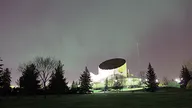The Visible Planets
Mercury is not visible this month. It is at inferior conjunction on September 13.
Venus shines brilliantly, low in the east-northeastern morning sky before sunrise. It starts the month of September in the constellation of Cancer, the crab, but quickly moves in the adjacent zodiac constellation of Leo, the lion, during the month. On September 1, Venus can be found just below the Beehive cluster, M44. During the predawn hours of September 19, look for Venus very near the waning crescent Moon and the bright star, Regulus, in Leo.
Mars continues to shine dimly exceptionally low above the west-northwestern horizon after sunset at the beginning of the month. It, however, slowly sinks into the light of the setting Sun, disappearing around the middle of the month. Throughout September, Mars will be located within the constellation of Virgo, the maiden.
Jupiter rises along the northeast horizon at around 2:00 a.m. at the start of the month and by 12:00 a.m. at the end of the month. It is located within the constellation of Gemini, the twins, where it stays for the rest of the year. Through the night, you can watch Jupiter slowly progress westward in the southern sky until it is found high, about 58°, in the southern sky by sunrise. Jupiter will be near the waning crescent Moon during the predawn hours of September 16. Look for a shadow transit of Jupiter’s moon Europa on September 16 as well.
Saturn is seen rising along the eastern horizon at sunset, traversing the southern sky through the night, and then setting along the western horizon by the time of sunrise. Saturn will be at opposition on September 20, a time that will provide nice telescopic views of the planet. Saturn is seen just below the circlet of Pisces this September. Look for Saturn near the Moon on the evenings of September 7 and 8.
Moon Phases
September 7 Full Moon (The Harvest Moon or Corn Moon) Total Lunar Eclipse from Asia
September 14 Last Quarter Moon
September 21 New Moon
September 29 First Quarter Moon
Special Events
International Space Station (ISS) Observable Passes
During the month of September there will be several favourable passes of the ISS. From September 1 to September 5, observable passes of the ISS will be found in our predawn morning sky. From September 9 to September 29, more favourable early evening passes will be seen between 7:00 pm and 11:59 pm. Exact times of these passages for your location can be found by visiting the website http://www.heavens-above.com or by using satellite tracking smart phone apps like Sputnik or Spot-the-Station.
September 1 Labour Day holiday
September 3/4 Transit of Titan’s shadow on Saturn occurs between about 11:03 pm to 3:11 am
September 7 Total lunar eclipse visible from Asia, Australia, Africa, and Europe. Not visible from North, Central or South America. Sorry, we must wait until next year for a total lunar eclipse to be visible from our location.
September 8 Royal Astronomical Society of Canada (RASC) Edmonton Centre meeting
Live in the Zeidler Dome at TWOSE and presented virtually through Zoom.
7:30 pm – 9:30 pm
Free for anyone to attend.
See http://www.edmontonrasc.com for more details.
September 16 to 21 Northern Prairie Star Party 2024
Black Nugget Lake, AB See https://edmontonrasc.com/northern-prairie-star-party/ for details.
September 19/20 Transit of Titan’s shadow on Saturn occurs between 10:41 pm to 2:00 am
September 21 Saturn at opposition (71-light minutes away)
September 21 Partial solar eclipse visible from Antarctica
September 22 Fall equinox occurs at exactly 12:19 pm MDT
September 23 Neptune at opposition
September 26/27 Shadow transit of Io on Jupiter upon Jupiter’s rising
September 27 Fall 2025 Astronomy Day
September 30 National Day for Truth and Reconciliation (Canada)




